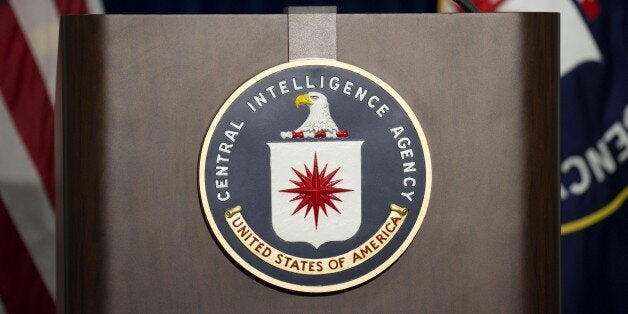
Honolulu, 1971. A diverse group of men and women walk into an office of the Honeywell Corporation to protest the company's manufacture of deadly cluster bombs. They have come to put their bodies in the gears of the war machine.
The "Honeywell 8," as the protesters came to be known, engaged in an act of civil disobedience to stop a brutal conflict. Decades later, a CIA draft memo reveals that just two months after 9/11, the agency had been frankly contemplating the use of torture -- and incredibly, it was invoking the Honeywell 8's legal defense to do so.
On trial for trespassing in 1971, the protesters summoned ancient English common law to argue that their crime was a "necessity" to stop Honeywell from making bombs. In the CIA draft memo, released last Tuesday as part of the Senate Intelligence Committee's torture report, the agency's general counsel cited the Hawaii Supreme Court's ruling on the Honeywell protest to argue that the crime of torture might similarly be a "necessity" to win the war on terror.
That argument would later be incorporated into the Bush Justice Department's infamous "torture memos." Whether by coincidence or an unnamed CIA lawyer's twisted sense of humor, the case of eight anti-Vietnam War protesters became a building block for a brutal program of waterboarding, forced rectal feedings and death.
"We wanted to save the lives of innocents in Indochina and spare them grief and pain," said John Witeck, one of the Honeywell protesters who is still active in the peace movement. "The CIA wanted to torture and kill."
***
Just as activists would later scorn the psychologists who contracted with the CIA after 9/11 to develop torture tactics, the Vietnam War protesters went to Honeywell's offices on May 14, 1971 to rebuke a major war contractor that manufactured the U.S. military's cluster bombs.
The peaceful invasion of the Honeywell office on Ala Moana Boulevard took place just a few weeks after a major May Day antiwar protest in Washington, D.C., which led to 12,600 arrests. The motley crew taking action in Hawaii included an airman, a housewife, a former State Department employee and a college newspaper editor.
The protesters filed their way into the office. Jake Marley, a sailor turned AWOL war objector, was the first to speak, telling the employees how bomblets could kill civilians over an area several football fields wide. The group hung a picture of one victim's grisly injuries on the wall to make sure the point was getting across.
Three hours later, the police came. Out of roughly 20 protesters, eight were charged with trespassing, and the gears of the legal system began to turn.
The brief episode did little more than inconvenience a startled Honeywell district manager. It likely would have been lost to history if not for the CIA draft memo revealed last Tuesday.
"What do CIA torturers and an 82-year-old nun have in common?" asked Bill Quigley, a law professor at Loyola University New Orleans. The answer to that riddle, apparently, is that both invoked the legal argument the Honeywell 8 used in their trial -- the "necessity defense."
The whole point of civil disobedience is that its practitioners know they are doing something illegal -- from the Honeywell trespassers to Sister Megan Rice, the elderly Catholic nun Quigley defended after she was charged with trespass and "sabotage" for sneaking into a nuclear weapons facility in 2012 as an act of protest.
Civil disobedience protesters, said Quigley, "are not at all surprised that they're prosecuted."
For many who engage in civil disobedience, the point of the trial is simply to garner more publicity. But when forced to make legal arguments, peace protesters often argue that, like the passerby who breaks the lock on a burning house to save a child, their trespass was necessary to stop the far greater evil of war.
"Breaking and entering into a house would ordinarily be a crime -- it is a crime, but the defense is that you took that action for the greater good to really save somebody," said Quigley.
In many states the necessity defense isn't written into law at all. Instead, it's been incorporated by tradition from old English common law to resolve a legal paradox: Why should those who commit minor crimes for a far greater good be held liable?
The first Honeywell 8 trespass trial in September resulted in a mistrial, a sort of moral victory for the protesters. The next trial, in October, ended in convictions for all eight of them.
After that, the protesters appealed to the Hawaii Supreme Court. Marley lent his name to the case, which would be called State v. Marley. In the case, the defendants argued that they had to trespass at Honeywell in order to stop the far greater crime of the Vietnam War.
They didn't really expect to win. "I was kind of the patron saint of lost causes," laughed their public defender, Rich Turbin, who is now a personal injury lawyer.
The protesters lost -- but they received a remarkably thorough hearing. In a long opinion that is still cited today, the judges explained when the necessity defense could work: If there was no legal alternative; if the harm to be prevented was imminent; and if there was a direct, causal relationship between the defendant's action and avoiding that harm.
"Although the Marley court decided the necessity defense was not available to these particular defendants, the standard they set out is the norm," explained a legal summary decades later.
That summary was written by the CIA.
***
George W. Bush categorically stated in 2006 that "the United States does not torture." But the CIA draft memo, revealed for the first time last Tuesday, shows agency lawyers planning to evade international and domestic laws against torture as early as 2001, just two months after 9/11. The draft memo came well before the March 2002 capture of Abu Zubaydah, the torture program's "guinea pig."
"Wow, that early," said David Luban, a Georgetown Law professor who has written extensively on the Bush administration's briefs that justified torture. "They're already figuring out [they] need some kind of cover-your-ass memo."
The memo is also notable because it calls torture what it is, rather than "enhanced interrogation techniques," the euphemism that the CIA has relied on in subsequent documents. Torture, the 2001 memo clearly states, is against the law.
But then the memo goes on to explain how to get away with breaking that law. The document says the agency could use "a novel application of the necessity defense to avoid prosecution of U.S. officials who tortured to obtain information that saved many lives."
Witeck called the CIA draft memo "horrendous." Turbin said its misapplication of his case was "scandalous."
The Nov. 26 memo came just days after the fall of the city of Kunduz, Afghanistan, a key Taliban stronghold that U.S. forces were targeting. "At this point the wholesale surrender of the Taliban forces began to cause problems," a U.S. Army history of the invasion explains. The war was going so well that all the surrendered prisoners were starting to create headaches, particularly as the CIA began to exploit those prisoners for intelligence.
On Nov. 25, just one day before the report was drafted, the U.S. saw its first combat death in the Afghanistan conflict. He was a CIA officer interrogating detainees, killed in an uprising at a Northern Alliance prison.
The CIA, for its part, claims "nothing in record" suggests the "rather obscure" draft memo was ever actually used. The agency asserted in its official response to the Senate torture report that the memo was "simply an example of Agency lawyers doing their jobs; examining all contingencies."
The necessity defense is almost always a legal Hail Mary. Quigley said he's defended hundreds of protesters and has never seen a federal court accept it. But it was clearly given serious contemplation at the CIA. The reference to the necessity defense was repeated in the infamous Aug. 1, 2002 torture memo authored by Justice Department lawyer John Yoo. He reportedly told a colleague that he included it on behalf of the CIA, because "they want it in there."
The CIA's lawyers admitted themselves that the necessity defense had never been invoked to defend torture in the U.S. (although it has been accepted in Israel). Luban argued that the agency lawyers had also made a serious mistake by failing to refer to U.S. v. Oakland Cannabis Buyers' Cooperative, a Supreme Court case decided only months before the draft memo was authored. That case, Luban said, would have cast further doubt on the CIA's legal argument.
Years later, the agency has yet to publicly acknowledge that its post-9/11 torture program was, in fact, a torture program. Current CIA chief John Brennan refuses to utter the word. Last week, the Obama Justice Department reiterated its decision that no one at the CIA will be prosecuted.
But for Quigley, the tell was there all along in that November 2001 memo, with its reference to the Honeywell 8. Whether trespass or torture, the necessity defense is only necessary if its proponents have committed a crime.
"They fully expected to have to answer for this stuff," said Quigley. "They had more faith in the American judicial and prosecutorial system than has actually come to pass."

